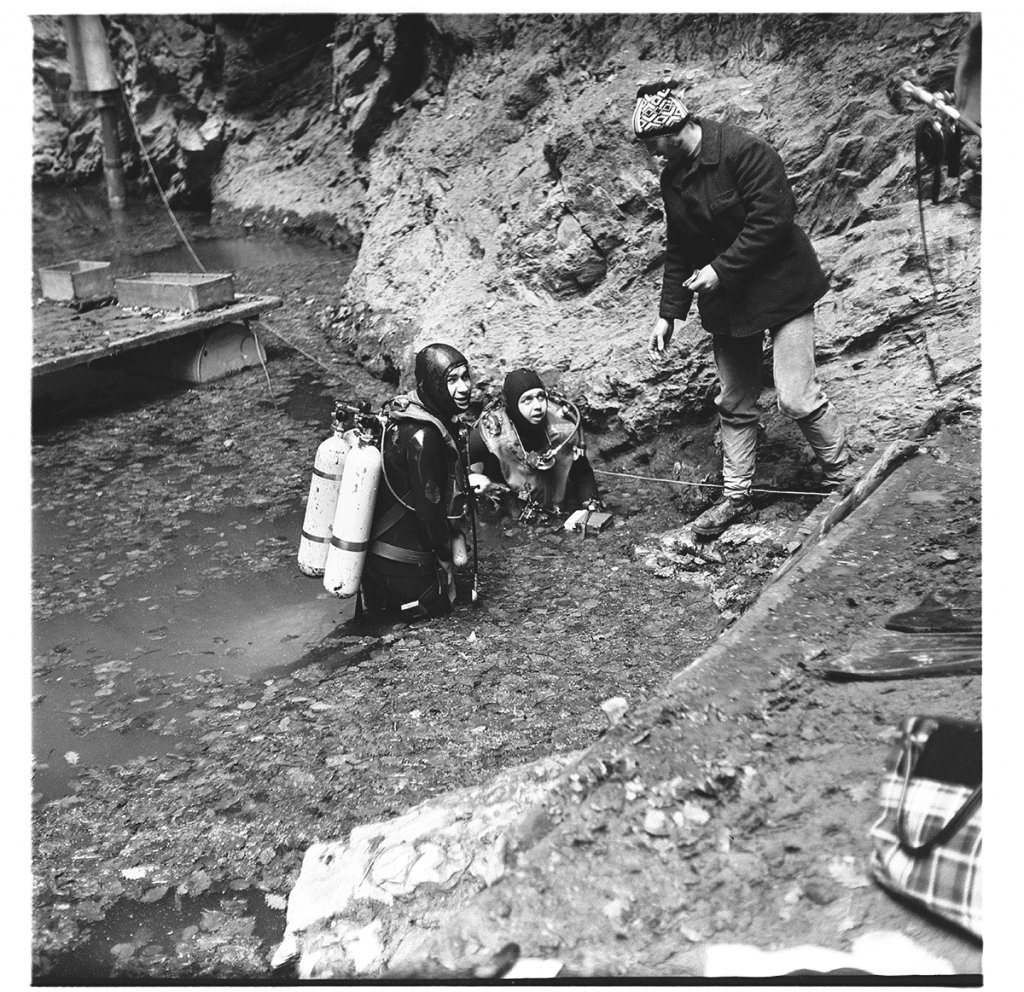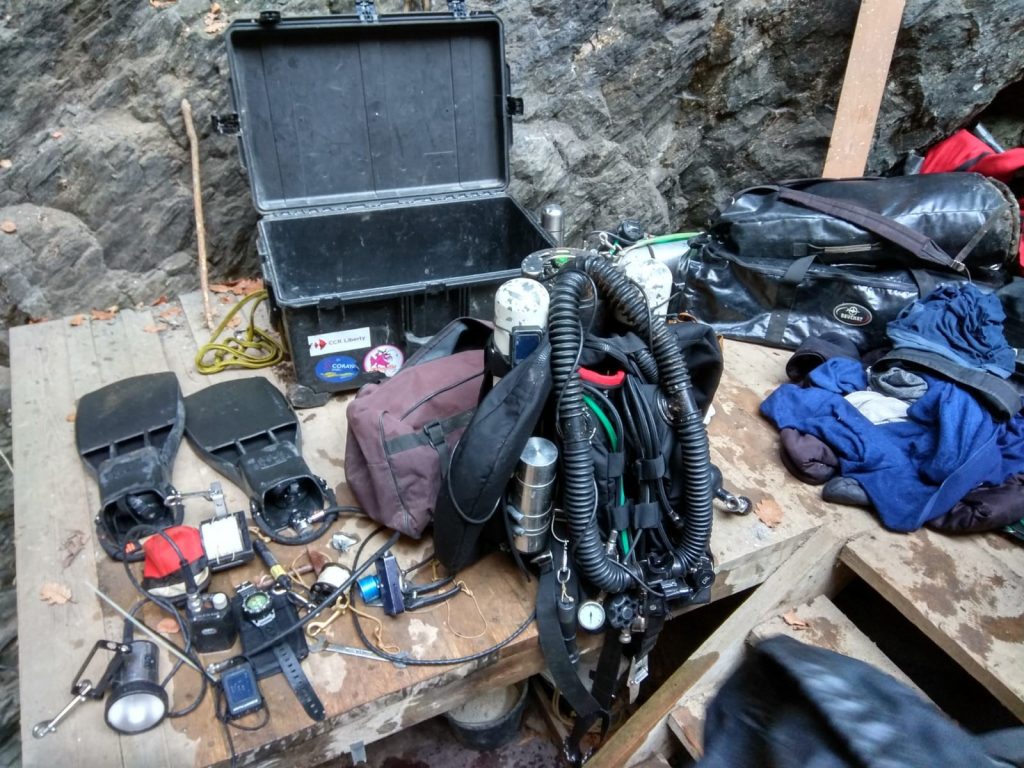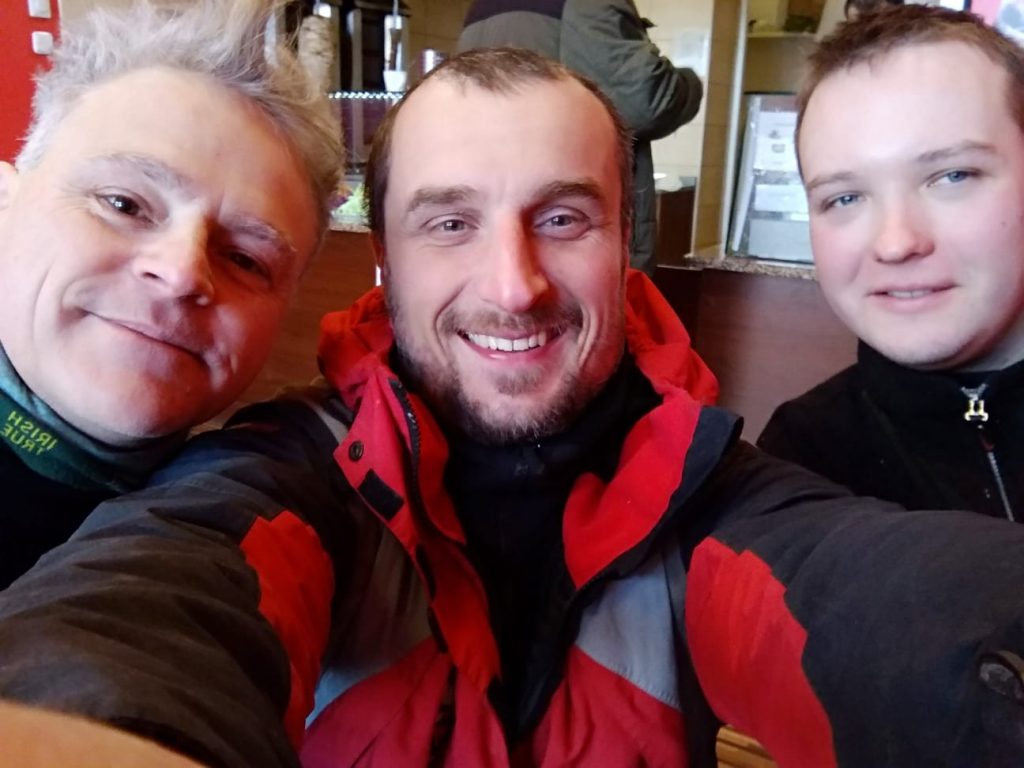Cave
Hranice Abyss: The Deepest Flooded Freshwater Abyss in the World
The efforts to explore and map Hranice Abyss, located in Hranice (Přerov District) in the Czech Republic span more than a century. Currently, the monstrous chasm is known to reach 384 m/1260 ft deep. Explorer and member of the Czech Speleological Society Michal Guba takes us for a deep dive.

By Michal Guba
The cave diving organization “7-02 Hranický kras,” which is a part of the Czech Speleological Society, is responsible for and has overseen the exploration of the Hranice Abyss, the deepest known flooded abyss in the world. The timeline below details the continuing exploration of the abyss. Please note that it is not easy to find divers who are technically and professionally prepared for exploration at a depth of about 200 meters/656 feet in a cave environment.

In addition to depth, the composition of the water in Hranice Abyss can cause problems for divers. It is a mineral water (‘kyselka’ in Czech) with a high content of CO2 (carbon dioxide), which irritates the exposed parts of a diver’s body. In addition, the water’s composition has influenced the choice of diving equipment. When using open-circuit scuba, the exhalation bubbles cause a chemical reaction in the surrounding water, resulting in a rapid deterioration in visibility—it drops to zero! For that reason, open-circuit dives to depths below 50 m/164 ft were “banned” in 2001. Since then, members of 7-02 Hranice Karst have used closed-circuit rebreathers, which don’t emit bubbles, for exploration beyond 50 m/164 ft. Currently, the dive team has standardized on Divesoft’s Liberty rebreather.
1580: The first unsuccessful attempt to determine the depth of the lake at the mouth of Hranice was conducted by a breath-hold diver in 1580 and was described by Tomáš Jordán of Klauznburk.
1900-1902: It was not until the turn of the 20th century that a professional teacher, J. V. Šindel of Hranice, repeatedly launched a weighted probe from a boat and reached a depth of 36 meters/118 feet. His findings were not challenged following exploration by geographer J. Dosedla in 1951, but they were quickly debunked by the arrival of divers and modern technologies.
1961: Bohumír Kopecký of Hranice made the very first dive in the Abyss with his handmade diving apparatus, reaching a depth of 6 meters/20 feet.
1963: RNDr. Jiří Pogoda conducted a systematic dive survey. He found that the bottom forms a slope obliquely pointing deep under the rock massif.



1977: Miroslav Lukáš discovered the first dry space behind Zubatice. The location is called Heaven for its decoration.
1978: Miroslav Lukáš and Jaromír Andrés discovered another dry space, named Dry Rotunda. There is a greater mouse-eared bat colony during the period from May to September.


1980: A special glider probe by RNDr. Jiří Pogoda reached an unbelievable 260 m/853 ft.


This was followed by several dives with helium breathing mixture.
1981: Fraňo Travěnec and Lubomír Benýšek descended for the first time with a trimix mixture to a depth of 110 meters/361 feet. After the borders opened in 1989, foreign divers also began to dive into the Abyss.
1993: Belgian Michel Pauwels reached a depth of 155 meters/509 feet with a trimix mixture. Depth probes continue to measure areas too deep for cave divers to reach.
1995: A remote-controlled underwater robot was first used in the Abyss. It was the ROV HYBALL, which at Lift I reached a maximum depth of 203 meters/666 feet; unfortunately, its supply cable got stuck in the fallen wood logs. The operator managed to maneuver it out but its Belgian owner, Carl von Basel, no longer wanted to continue the survey.
2000: Krzysztof Starnawski, who made the “last” deep dive with open-circuit scuba, reached a depth of 181 meters/594 feet and saw the bottom of the core of the Abyss, called Lift I. After the year 2000, divers began using closed-circuit rebreathers, which enabled them to stay longer at deeper depths.
2003: The underwater robot ROV COLOMBO of the Main Mining Rescue Station a.s. (OKD Ostrava of the Czech Republic) was used to survey Lift I and the “New York” area. It reached a depth of 140 meters/459 feet but was limited by the length of its communication cable (150 meters/492 feet).
For a long time, it was certain that Krzysztof Starnawski of Poland and Pavel Říha saw the bottom at a depth of about 200 meters/656 feet, and that the possible continuation of the vertical direction did not lead directly to the current survey. Therefore, it was decided to provide an underwater robot rather than a diver to investigate the terrain and suggest further action. It was agreed to revive earlier collaboration with the Polish cave diver Krzysztof Starnawski.
2002-2010: Pavel Říha conducted an in-depth survey and mapped Lift I at a depth of 170 meters/558 feet.
2011: Krzysztof Starnawski had just finished testing a unique, double closed-circuit instrument with which he dove in the Red Sea to the depth of 283 meters/928 feet.
January 2012: Krzysztof Starnawski settled his 2000 record at 181 meters/594 feet at the Abyss. Two days later he descended to a depth of 197 meters/646 feet, creating a new depth record and discovering a narrow passage (restriction) on the north side that could perhaps be explored.
June 2012: Krzysztof Starnawski achieved an extraordinary discovery in another dive when with much difficulty, he overcame the restriction and descended to a depth of 223 meters/732 feet. By doing so, he confirmed that the Hranice Abyss continued to a greater depth than previous calculations.
October 1, 2012: On his next dive, Starnawski descended to a depth of 223 meters/732 feet and launched a new probe, which reached 384 meters/1260 feet, setting a new Hranice depth record.
Since 2014: Members of ČSS ZO-7-02 Hranický kras have been using the Divesoft technology for exploration and research into the abyss. Specifically, the Liberty rebreather (back- and sidemount versions) enables members of ZO-7-02 Hranický kras to perform complex work activities up to 100 meters/328 feet (drilling, enlarging holes, positioning sensors, etc.), which fully utilizes the properties of the rebreather, such as low work of breathing and maintaining an optimal PO2. Members conducting dive surveys were also equipped with Freedom dive computers to ensure their safety in the complex depths and so-called “yo-yo profiles” in the Hranice Abyss, and providing for compatibility among the dive team.


June 2015: David Čani made a dive to a depth of 181 meters/594 feet (a new Czech depth record), in which he checked the status of the Lift I axis and, along with other dive participants, practiced procedures to ensure the safety of deep divers performing dives down to 200 meters/656 feet and below.
July 2015: Krzysztof Starnawski made a dive to a depth of 220 meters/722 feet, and then launched a probe with an electronic pressure sensor. This time he measured the depth of just 365 meters/1198 feet. However, at the ascent, he made a very promising discovery when he examined a new restriction at a depth of 204 meters/669 feet and found that it opened into a passage big enough to drive a Tatra (a truck) through. This discovery was of paramount importance for the safety of divers making dives across the strait at the bottom of a massive well that was previously named as Lift I, because it might give them an alternate exit path.
August 21, 2015: Krzysztof Starnawski made a dive into another well (called Lift II), which was accessible after crossing the strait at a depth of 204 meters/669 feet and has approximately the same slope as Lift I. In this dive, Krzysztof discovered a new opening at 240 meters/787 feet (rock window) into unknown spaces, which he named “Macejko.” In doing so, Starnawski reached a maximum depth of 265 meters/869 feet, setting a new world depth cave record.
2016: The members of the Hranice Karst joined with National Geographic for the “Hranická Propast Step Beyond 400 meters” project with the help of Bartolomiej Grynda, owner of Gralmarine, to test an underwater ROV. On September 27, a new depth of 404 meters/1325 feet was reached during the Gralmarine ROV test dive, making the Hranice Abyss the deepest flooded cave in the world. The robot was again limited by the length of the communication cable of 500 meters/1640 feet.
The ROV descended to the bottom of Lift I to the “Mikado” restriction and entered the Lift II. In Lift II, Grynda maneuvered the ROV along the cord of the measuring probe to a depth of 384 meters/1260 feet. After reaching the end, he proceeded along the wall to a depth of 404 meters/1325 feet. The robot remained “tangled” near the “Mikado” restriction in Lift I at close to 200 meters/656 feet. The robot was eventually rescued in 2017 by 7-02 Hranický kras and members of the Department of Special Diving Activities and Training from the Police Presidium of the Czech Republic.



2018: Working with the town of Hranice, the ČSS ZO 7-02 Hranický kras opened an information center at the Teplice nad Bečvou railway station detailing the current state of the Abyss exploration. There are 3D glasses available to help the tourists dive into the waters of the Abyss.
“During the dives, we discovered new irregular spaces, which will require further exploration. They are mostly deep and relatively narrow. However, none of the Hranice Karst speleologists doubt that there are still interesting discoveries to be made at Hranice Abyss,” explained 7-02 Hranický kras chairman Michel Guba.
At the moment, speleologists are working to produce maps of both the dry and flooded parts of the Abyss from top to bottom in 3 meter/10 foot increments. At the same time, photographic and video documentation is being conducted to help refine individual measurements.
To create greater awareness of the entire flooded and dry underground labyrinth to the public, all the measurements have been input into mapping programs to create a 3D model. Currently a profile of the cave is displayed on an information board showing the known spaces of the Abyss.
Currently there is an information board with a profile showing the current state of the known spaces on the observation ring near the Abyss.

Hranice Abyss Facts:
- The deepest abyss of the Czech Republic.
- The deepest flooded freshwater abyss of the world.
- First written reference: 1580
- Recorded on map: 1627
- Cadastral area: Hranice.
- Edge elevation of Abyss: 315 meters/1033.46 feet above sea level.
- Entrance dry esophagus of the Abyss: length 104 meters/341 feet, width 34 meters/111 feet, depth 69.5 meters/228 feet.
- The depth of the flooded part: 404 meters/1325.46 feet (2016).
- The total depth of the Abyss: 473.5 meters/1553.47 feet.
- Depth reached by divers: 265 meters/869 feet (2015).
Dive Deeper:
InDepth: The Challenges of Exploring Hranice Abyss by Petra Pruden
BIP: INESC TEC breaks world depth record in the exploration of flooded caves (2022)

Michal Guba worked as a policeman from 1992 to 2017. From 2008 to 2017, he worked as a lecturer, instructor, and deep diver. During a rescue mission (there was a huge flood in the Czech Republic in 1997), Michal decided to take a diving course at CMAS and began diving in 1998. Since 2000, he has been a part of the Hranice Abyss speleo diving team and is currently the chairman.
Michal participated as an expert (de-mine-pyrotechnic and training) on foreign missions in Switzerland, Austria, Bosnia and Herzegovina, Serbia, Croatia, and Montenegro from 2011 to 2016. Michal was awarded the Golden Rescue Cross in 2007 by the President of the Czech Republic Klaus and has received additional awards for his police work. Michael is currently employed by Czech company TRESPRESIDENTES s.r.o.



















































